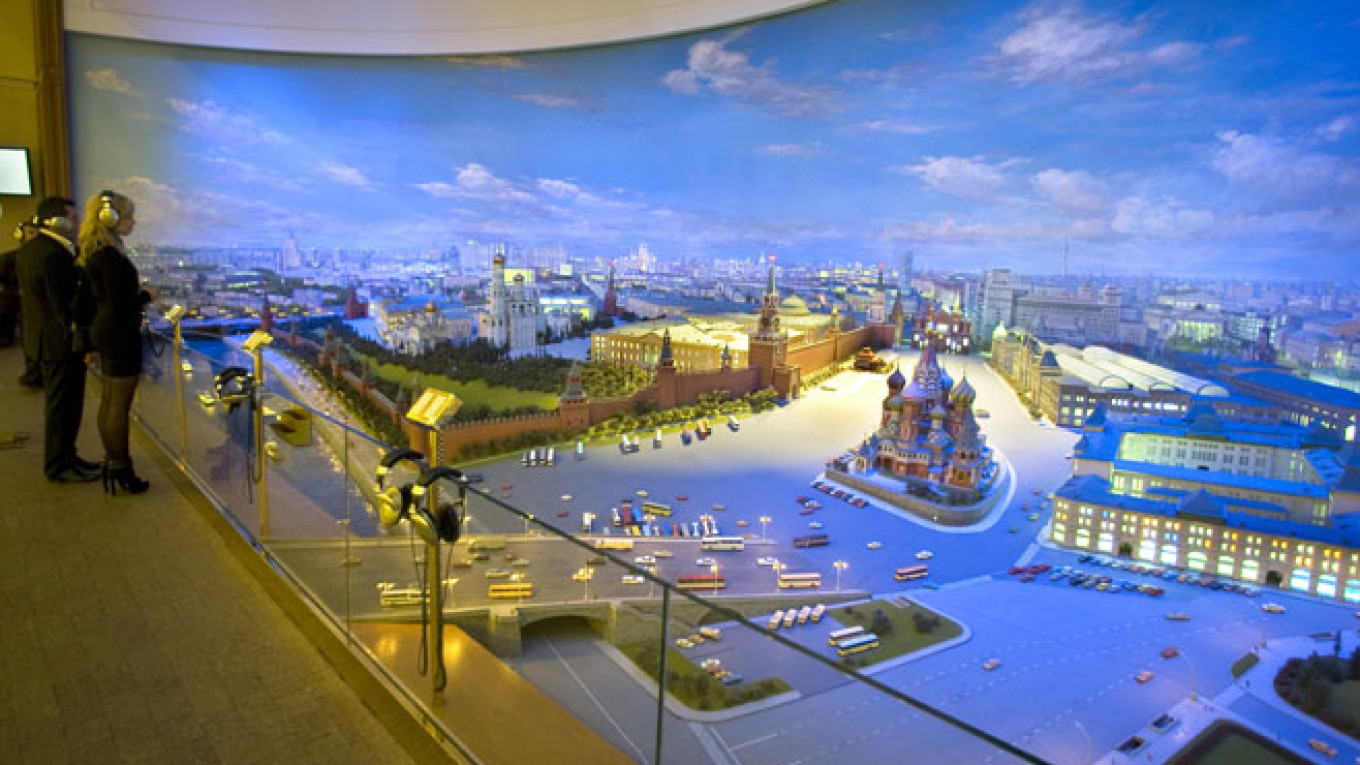Most people have heard of Novaya Moskva, or “New Moscow,” the extension of the city’s boundaries, where government offices will one day move, but few know of Moskva Malaya, or “Small Moscow,” which is currently being built.
Small Moscow is a mini model of the city using a scale of 1:400, which means it will eventually stretch to a grand 945 square meters.
Deputy Moscow Mayor Marat Khusnullin launched the project after visiting a model of Beijing on a visit to China in 2011. Eighty employees are spending 1 1/2 years making the 67,000 mini buildings that go into the model. Moscow, up to the boulevard ring, is already finished and will go on show next year in the Moskva pavilion at the VDNKh exhibition center.
In an architectural center on Brestskaya Ulitsa, one of the model’s administrators, Sergei Podyomshchikov stares at the plan for the city, which hangs on the wall.
“Why does it only go up to the Third Ring Road?”
“Because otherwise it would not fit in the building,” he said.
The mini city copies the original in many ways. The Kremlin chimes ring out in the mini Kremlin as do the bells on the Christ the Savior Cathedral. Special Japanese technology is being used to make Moscow trams for Small Moscow.
Buildings are still rising up in the modelers’ room. Everyone sits around a monitor where a 3-D model of a building is being created. These models are then printed out. A simple building can take just 20 minutes, one with stucco moldings can take several hours.
“I also saw the model which Khusnullin saw in Beijing,” said Podyomshchikov, “It was all dirty, broken. They not only did not have any windows in the building but not even window frames … And so much dust on the roads. The trees are not planted in the parks; you have the impression that they simply burst out of the ground.”
In the next room, a young man holds a soldering iron which he is using to give every building electricity. Seven kilometers of wires are being be laid for every 50 meters of the model. Eventually you will be able to press a button to light up a house, street and more. A simple request and all of Gogolesvky Bulvar will light up or even all of the higher education institutes in Moscow.
The Small Moscow builders have run into a number of problems. Getting access to architectural plans of the city’s buildings has not been easy even though they are working for the city government.
“They just do not give them and the model makers need an accuracy to 30 centimeters,” said Oleg Didenko, the manager of the project. “It is secret information.”
Instead the modelers take photos of the buildings but it is far less accurate and they have had difficulty getting access. Photographers were stopped and questioned after they took photos from the historical museum on Red Square, even though they had permission.
“Thank God, there are now panoramic views of the Kremlin on the internet as not that long ago you could not even find [photos of] the internal facade of the Senate [within the Kremlin],” said Podyomshchikov.
“Where is it better to live in Small Moscow or Big Moscow?”
“Definitely, absolutely in small Moscow,” said Podyomshchikov, “When we put together the central part, the modelers themselves said: “How great! Who knew we lived in such a beautiful city.”
In the cellar, large chunks of Moscow lay around waiting to be pieced together for the exhibit at VDNKh.
On the streets of Small Moscow, miniature cars can be seen, although all of them are a strange silver color and of the same shape.
A gloomy man with an earring is making trees. He takes out miniature trees made from lifeless copper wire, sprinkles green shavings on them and summer has arrived in mini-Moscow.
“Do you only have evergreens?” I asked.
We also have fir trees,” replied the tree man.
“How can you have Red Square without fir trees?” added Podyomshchikov.
“Is there a mausoleum there? Have you made a Lenin?”
“It is there but I have not looked inside,” said Podyomshchikov
Small Moscow is beautiful but it is still weird to look at; you cannot see anybody through the windows, the roads are deserted, there is no one in the courtyards.
“Where are all the people. There are cars but no pedestrians.”
“Cars are bigger than people. You would have to put hundreds of thousands of people there in order for them to look like people,” said Podyomshchikov, “Otherwise they look like specks of dust which you want to blow away.”
Contact the author at artsreporter@imedia.ru
A Message from The Moscow Times:
Dear readers,
We are facing unprecedented challenges. Russia's Prosecutor General's Office has designated The Moscow Times as an "undesirable" organization, criminalizing our work and putting our staff at risk of prosecution. This follows our earlier unjust labeling as a "foreign agent."
These actions are direct attempts to silence independent journalism in Russia. The authorities claim our work "discredits the decisions of the Russian leadership." We see things differently: we strive to provide accurate, unbiased reporting on Russia.
We, the journalists of The Moscow Times, refuse to be silenced. But to continue our work, we need your help.
Your support, no matter how small, makes a world of difference. If you can, please support us monthly starting from just $2. It's quick to set up, and every contribution makes a significant impact.
By supporting The Moscow Times, you're defending open, independent journalism in the face of repression. Thank you for standing with us.
Remind me later.






